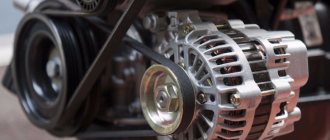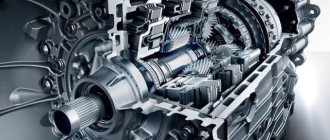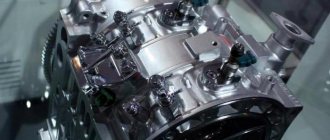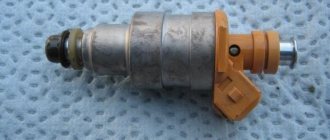Home » Engines » 2.0 fsi injection system - what is it, history, advantages
The English term “Fuel Stratified Injection” - abbreviated as 2.0 fsi, translates as fuel injection in layers. Why did this term appear and what is its scope?
The pioneers in installing engines with gasoline supply in layers, that is, 2.0 fsi, in cars are Japanese automakers. They were the first to understand and appreciate the promise of the design feature of gasoline engine power supply, in which fuel does not enter the engine intake manifold, but directly into the cylinders, and applied this advanced technical solution in engines installed on Mitsubishi cars.
At the beginning of the twenty-first century, the German auto concern Volkswagen made great efforts to develop this advanced technical idea, and created a whole family of engines with stratified fuel supply, engines with the abbreviation FSI.
Technique
The 2-liter engine with direct fuel injection is a modern design. In addition to a special injection system, this engine has pistons and a 16-valve head made of aluminum alloy, an intake manifold with air flow control flaps, and a variable valve timing system.
A timing belt is responsible for the timing drive, but in some TFSI versions it is a chain (since 2008 - CAWA, CAWB, CCTA, CCZA and CCZC). The injection system uses a high pressure pump and an exhaust gas recirculation valve. The TFSI engine is constantly evolving, and currently the flagship version of the engine has a power of 272 hp.
Let's try to understand how these 2.0 fsi power plants work, what are their advantages and disadvantages.
The basic principle of operation of engines with a 2.0 fsi fuel supply divided into layers is that, with the help of a high-pressure pump, the fuel gets directly to the place where it will ignite. Special sprayers, with several technologically precisely selected holes, create an air-fuel cloud of a concentration strictly specified at each moment of time directly in the area of the spark plug electrodes.
The concentration of the combustible mixture is controlled by special dampers - electronic controllers. This technical solution ensures maximum optimality and efficiency when operating a gasoline engine. The composition of the fuel is required to be homogeneous and optimally saturated.
In engines with 2.0 fsi gasoline supply, unlike other engines, a double fuel supply is possible, divided in time during one stroke of the four operating cycles, the intake and compression cycle. This helps bring the catalytic converter into working condition and helps the engine start at low temperatures.
Let's look at the most important, from a design point of view, components and parts of an engine with a 2.0 fsi injection system. The gasoline movement system in these engines is divided into 2 parts: high pressure and low pressure. The main component of the high-pressure part is the fuel injection pump, which maintains the required fuel pressure in the spray nozzles.
Injection pump parts are manufactured with great precision. A four-sided cam located on the exhaust valve timing shaft drives the high-pressure pump. This ensures good homogeneity of the combustible mixture, the high-quality combustion of which reduces the emission of harmful substances into the environment.
The high pressure part includes, in addition to the injection pump, a fuel line, a control unit, a safety valve and nozzles. The low pressure part is used to move gasoline from the gas tank to the high pressure part. The low pressure part is formed by a fuel pump, structurally located in the gas tank, a gasoline filter, a valve and a regulator.
Owners of cars whose engines use a stratified injection system note good engine efficiency, high power and excellent torque. The engine pulls well from low end, with smooth and powerful acceleration throughout the entire torque range.
Cost of spare parts ($) *
| Details | Dealer | Analogs |
| oil filter / air | 9/25 | from 7/20 |
| spark plug | 10 | 9 |
| turbocharger | 1100 | from 800 |
| thermostat | 25 | 20 |
| water pump | 50 | 30 |
| coils (pcs.) | 50 | 30 |
| dual mass flywheel | 600 | 300 |
* For 2.0 TFSI / 200 HP (2006).
Significant differences between FSI and regular gasoline
- The injection is distributed directly into the combustion chamber, unlike a simple gasoline injection, where it is initially distributed into the intake manifold;
- The injectors contain similar holes through which the fuel mixture is sprayed into the combustion chamber. There are six of them in each.
- Oxygen is supplied through a valve that supplies fuel in portions, as a result the mixture becomes uniform, neither rich nor lean. Fuel is burned as completely as possible;
- Efficiency of up to 25%, environmental friendliness, acceleration dynamics, and not only make the FSI system an order of magnitude higher than its analogue.
How does the FSI system motor work?
Power plants with FSI technology are now installed in almost all vehicles of large automakers. This highly efficient system significantly increases the capabilities of a conventional engine. These motors have the best acceleration dynamics in their class. One of its main advantages is fuel savings of up to 25%. The volume of such engines ranges from 1.4-5.2 liters.
The FSI fuel system in this unit is designed similarly to diesel engines: the fuel pump powerfully forces fuel into the rail. Fuel injection, controlled by a solenoid valve system, is carried out using injectors. Each injector is opened after a signal is given by the central control unit. The operating phase depends on two conditions: engine speed and load.
Also, a motor with FSI differs from a conventional unit in the following:
- Oxygen enters the unit through a valve that controls the fuel supply. The mixture turns into the same type, and the fuel burns out almost immediately.
- FSI is much higher in terms of acceleration, efficiency, and environmental friendliness.
- The injectors have six holes through which the fuel mixture is evenly sprayed.
In addition, the camshaft in FSI engines rotates by 41°, providing better traction when driving in 1st and 2nd gear. Spent exhaust gases pass through the system, which significantly reduces the emission of harmful substances.
According to experts and users, power plants operating with FSI technology are more advanced and are recommended for operation.
They are distinguished from other motors by the following:
- Increased power.
- Improved dynamics.
- Reduced fuel consumption.
- Reducing exhaust gas emissions into the atmosphere.
Also a positive side of the FSI engine is the presence of 2-circuit fuel injection. The process occurs as follows: fuel enters from the first circuit at high pressure, from the second circuit at low pressure.
Features of TSI engines
This unit differs from the FSI engine by its fuel injection system. It is equipped with an additional mechanical compression system. The design of this motor is quite complex, but this disadvantage is compensated by its greater power, reliability and efficiency.
The layout of the TSI unit is special in that its mechanical compression system and turbocharger are located on opposite sides of the engine. A traditional turbocharged unit receives additional power using the energy of exhaust gases, which through the drive system, spinning the turbine wheel, create air injection. If we compare such an engine with a classic gasoline engine, then the efficiency of the engine with a turbocharging system with a TSI system is much more efficient.
When starting a cold TSI unit, double injection occurs. This function is designed to quickly warm up the catalyst immediately after starting the engine. The first time this happens during the fuel suction stroke, the second time - if the crankshaft of the unit during rotation has not reached 50° to the top “dead center”. If the unit operates under normal operating conditions, fuel is supplied only during the suction stroke, evenly distributed in the combustion chamber.
The injectors installed on the TSI engine have six fuel injection channels. Thus, the direction of individual fuel jets prevents the elements of the internal combustion chamber from being moistened, thereby ensuring optimal distribution of the fuel-air mixture. This allows you to achieve a high fuel injection pressure and guarantees high-quality preparation of the fuel mixture, as well as its reliable atomization. Thanks to this, there will be enough fuel even under maximum loads.
On TSI engines, fuel does not enter the intake manifold, but directly into the cylinders. The formation of the mixture occurs “layer by layer”, while high-quality combustion occurs with maximum efficiency. These factors make it possible to slightly increase the power of the unit and reduce fuel consumption.
Motor circuits
Engines with the FSI system have two circuits: with high and low pressure. The presence of a high-pressure circuit increased the efficiency and performance of the power unit. The required pressure is maintained by the fuel pump. If the need arises, the pump takes fuel and lubricants in an area with lower pressure. The filter, fuel tank with pump, low pressure sensor - all this is part of the low pressure circuit. After the signal arrives at the sensor, it goes further to the control unit. Electronically, the received data is compared with standard ones according to the selected mode. If the data is different, the corresponding signal is transmitted to the fuel unit. This block changes the rotation speed, thereby increasing productivity. Next, the high pressure circuit promotes the injection of fuel that has arrived.
Advantages
Among the main advantages of motors are the following. This is higher efficiency due to the unique features of the FSI engine. The unit also boasts reduced fuel consumption compared to naturally aspirated engines with conventional distributed injection. The unit also produces less harmful emissions into the environment.
FSI engines
When choosing a car, many people want to hear the roar of the engine and experience the speed and power of the power unit. These indicators are a priority for many car enthusiasts. But not everyone knows the rather primitive things that these indicators depend specifically on the engine. Everything can influence engine performance: design, material. These same indicators also affect environmental friendliness, ergonomics, and fuel economy. Each owner should have a clear idea of what is under the hood of his “horse” and roughly understand what it can be capable of.
Advantages of the FSI engine
The FSI engine has a number of positive characteristics that distinguish it from engines of other systems.
- Thanks to the presence of an electromagnetic valve, the moment of fuel supply to the cylinder is very accurately determined.
- This system provides good traction performance at medium and low speeds.
- Comparing the economic performance of the FSI engine with other types of engines, gasoline savings reach 25%.
- Exhaust gases are repeatedly recirculated, this reduces their toxicity.
Distinctive features of the FSI motor
Unlike the FSI engine, in a conventional unit fuel injection occurs into the engine pistons through the intake manifold. But with the FSI product, this process is carried out directly into the combustion chamber. The injectors here have six small holes that distribute fuel throughout the combustion chamber with the greatest efficiency. Due to this, the fuel mixture has a homogeneous structure, which improves its combustible properties in the cylinders. FSI direct injection engines are significantly superior to conventional power units in acceleration dynamics, minimal carbon dioxide emissions, and fuel efficiency.
How does the FSI system motor work?
FSI technology engines have the possibility of double fuel injection, which is used when starting a cold engine. While it is warming up, a more enriched mixture of fuel enters it. A number of manufacturers, including Audi, have modified this system and installed a turbine, resulting in the TFSI. There are many different modifications with a volume of up to 5.2 liters. And there’s nothing to even say about the versatility of FSI: it is practical and economical, becoming more and more popular.
Let's sum it up
Summarizing all the pros and cons of FSI, its efficiency and cost-effectiveness, we can conclude that such technologies have a future and their further modernization is just around the corner.
FSI (Fuel Stratified Injection) engines from Volkswagen are car power units created using innovative technologies in which fuel is injected directly into the combustion chamber. This fuel supply technology has significant advantages over other fuel supply systems. Today, the most successful FSI engines are the engines of the Volkswagen concern.










